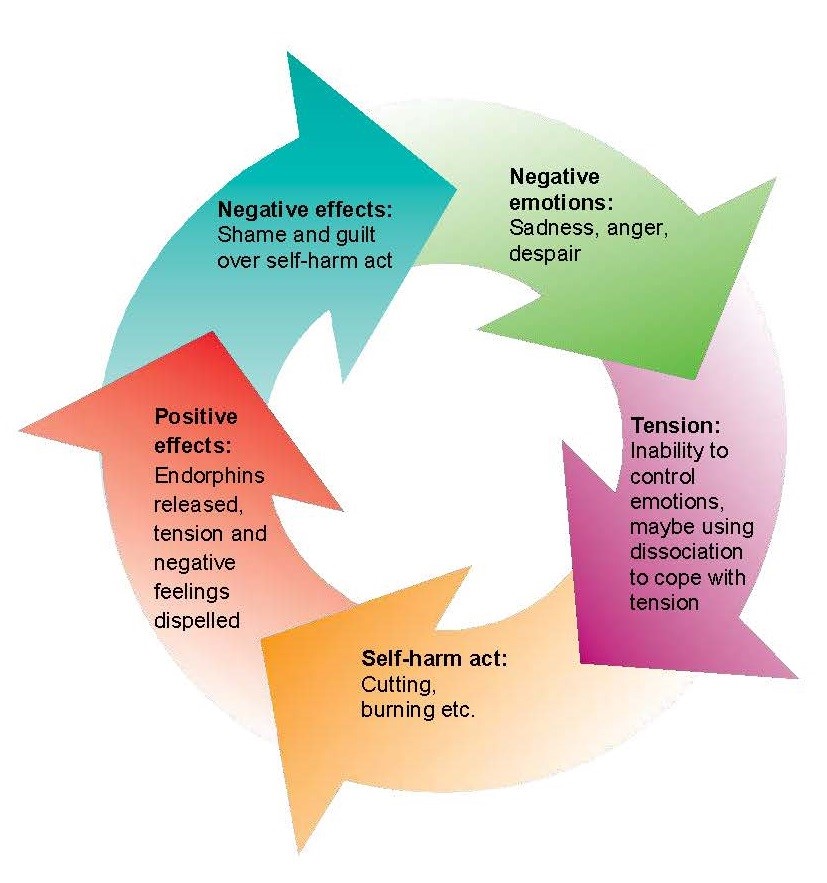Understanding Self-Harm
SELF-HARM, also known as self-injury, self-mutilation or Non-Suicidal Self-Injury Disorder, is a complex and often misunderstood behavior where individuals intentionally inflict harm upon themselves. This behavior is usually a coping mechanism for dealing with intense emotions, psychological distress, or trauma.
Understanding the extent and prevalence of self-harm in children and adolescents is extremely difficult as self-harm is often hidden and statistically only reported when significant harm is experienced however, the reported cases of hospitalisation due to self-harm, increased by 22% in the past year alone.
Understanding the cycle of self-harm and the different types of self-harm is crucial for providing appropriate support and intervention.

TYPES OF SELF-HARM:
1. Cutting
Cutting is one of the most common forms of self-harm. Individuals may use sharp objects such as razors, knives, or even glass to make superficial or deep cuts on their skin, often on areas that are easy to conceal, like the arms, thighs, or abdomen. The act of cutting can serve as a way to express inner pain or to feel something when emotional numbness takes over.
2. Burning
Burning involves using heat to damage the skin, typically with lighters, matches, cigarettes, or heated objects like metal. The resulting burns can range from mild to severe, depending on the method used and the individual’s intent. Burning may serve as a means to outwardly express internal pain or to regain a sense of control over one’s body.
3. Scratching or Pinching
Some individuals engage in repetitive scratching or pinching that causes skin damage. This can include using fingernails or other objects to scratch or pinch until the skin breaks or bruises form. This behavior is often less visible but can be equally harmful and is sometimes a precursor to more severe forms of self-harm.
4. Hitting or Banging
Hitting oneself, often by punching walls or other hard surfaces, or banging one’s head against a wall or another object, is another form of self-harm. This type of self-injury is typically driven by intense frustration, anger, or self-directed hatred and can result in bruises, broken bones, or concussions.
5. Hair Pulling – (Trichotillomania)
Hair pulling, or trichotillomania, is a form of self-harm where individuals compulsively pull out their own hair, often from the scalp, eyebrows, or eyelashes. This behavior can lead to noticeable hair loss, bald patches, and emotional distress. It is often linked to anxiety, stress, or obsessive-compulsive tendencies.
6. Cheek Biting
Chronic cheek biting and chewing is considered to be a body-focused repetitive behavior (BFRB) similar to hair pulling (trichotillomania). It corresponds with anxiety related problems. BFRBs are behaviors that are repeated despite continuing attempts to stop them. They become disorders when they get in the way of a person’s quality of life and cause injury or distress. BFRBs typically start in late childhood and continue into adulthood.
7. Interference with Wound Healing
Some individuals engage in picking at scabs or deliberately interfering with the healing of wounds. This can involve reopening cuts, scratching at healing skin, or even infecting wounds intentionally. This type of behavior can lead to prolonged healing, infections, and scarring.
8. Ingesting Harmful Substances
Ingesting harmful substances, such as household chemicals or medications in non-lethal doses, is another form of self-harm. While this behavior may not be intended as a suicide attempt, it poses significant health risks, including organ damage or poisoning. It is often used as a way to cope with overwhelming emotions or to punish oneself.
9. Risky Behaviors
Engaging in deliberately risky behaviors, such as reckless driving, substance abuse, or unsafe sexual practices, can also be seen as a form of self-harm. These behaviors are often driven by a desire to escape emotional pain, to feel a sense of control, or as a cry for help. While not always classified as traditional self-injury, these actions can be equally harmful and indicative of underlying psychological issues.
10. Bone Breaking or Fracturing
Though less common, some individuals may intentionally break or fracture their own bones as a form of self-harm. This can involve hitting oneself with heavy objects or deliberately falling in a way that causes injury. The physical damage is severe, and the behavior is often linked to extreme psychological distress or dissociation.
UNDERSTANDING THE ROOT CAUSES:
Self-harm is typically a symptom of underlying mental health conditions, such as depression, anxiety, bullying, or low self-esteem. It may also be a response to trauma, abuse, or feelings of worthlessness. For some, self-harm provides a temporary relief from emotional pain, while for others, it is a way to regain a sense of control or to punish themselves.
SEEKING HELP:
Recognising the different types of self-harm is the first step in providing effective help. If you or someone you know is engaging in self-harm, it is crucial to seek professional support. Therapy, particularly NLP, can be highly effective in helping individuals understand and manage their emotions in healthier ways. Additionally, addressing the underlying causes of self-harm through a structured treatment plan is essential for long-term recovery.
CONCLUSION:
Self-harm is a serious issue that requires understanding, compassion, and appropriate intervention. By recognising the various forms it can take, we can support those who struggle with it and guide them toward healthier coping mechanisms and healing.
By: Michelle Booth
07624427650

Leave a Reply